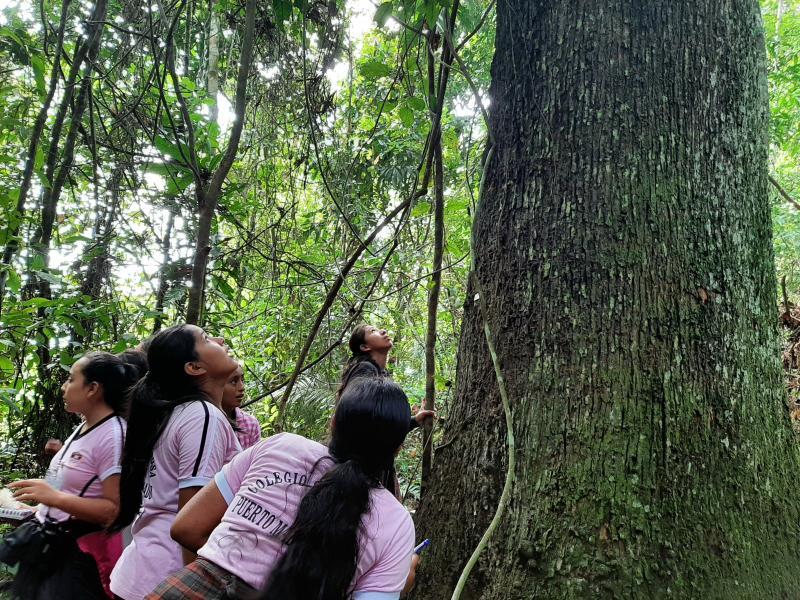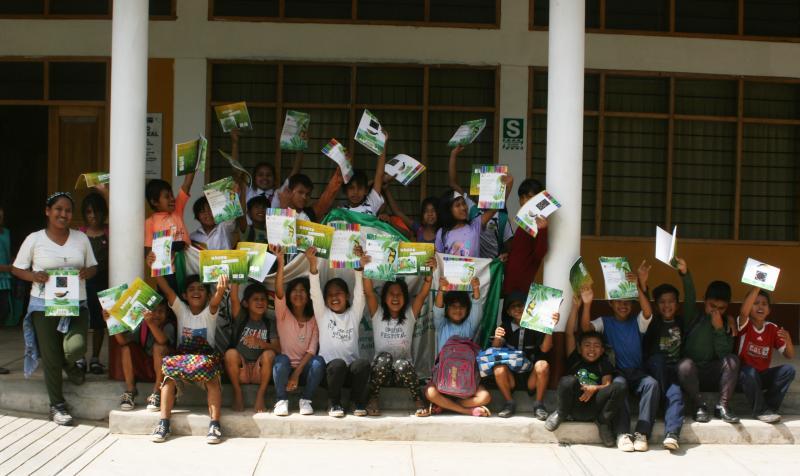Image

-
Raquel Condori
Environmental Education Project Coordinator, Amazon Center for Environmental Education and Research (ACEER)
- 30 Under 30
- 2019
Puerto Maldonado, Perú SEE OTHER BIOS HERE
Age: 29
Raquel's efforts give hundreds of kids, teenagers, and adults the opportunity to explore and appreciate the beauty and importance of the Amazon rainforest.
Tell us about yourself!
My work focuses on rainforest conservation since I grew up surrounded by an incredible diversity of plants and animals. I started as a volunteer at my university, at the Tambopata National Reserve, and at the Ministry of Environment, and I also lived and worked with several local communities in the region. I studied ecotourism at the Amazonian National University in Madre de Dios, Peru, and conducted my thesis research thesis in an Ese’Eja community. While there, with nine colleagues, we created a cultural association called the Green and Cultural Union which focuses on environmental education and aims to help the children grow proud of their community and maintain their cultural heritage.
In 2014, I joined the Amazon Center for Environmental Education and Research (ACEER), where I promote environmental education through informal teaching. I currently coordinate our Puppet House project, where I bring students to the forest to show them the importance of valuing and taking care of this ecosystem, and we finish the activity with a puppet show. The puppet characters are wild local animals that demonstrate local environmental problems including deforestation, forest fires, and mercury contamination of water due to illegal gold mining. Finally, I also recently joined the Program for Bat Conservation in Peru as the local coordinator for their efforts in Madre de Dios.

The region where I live is known as the biodiversity capital of Peru. However, since childhood, I have seen many environmental problems of my region, including many disastrous impacts that the Peruvian Amazon has suffered lately. Unsustainable human activities are mostly to blame, including wood extraction, gold mining, and oil exploitation, all due to peoples’ lack of environmental awareness. These activities continue to harm our various rainforest ecosystems, including areas that are protected by the states, leaving a lot of wildlife without a habitat. Because of all of this, I felt that I had to do something. I love nature and am glad that I found the opportunity to work with the people at ACEER, who also care for the environment and education, so that I know I am not alone in this endeavor. Thanks to this organization, I have been able to participate in many courses and workshops about biodiversity and conservation. Today, I am doing what I am passionate about, transmitting all the knowledge that I have learned over these years. I believe that children are the future citizens of the world, and it is very important that they grow into environmental leaders with the power of knowledge and the hope that we can still save our Amazon.
What advice would you give to the next generation of leaders that are looking to bring about positive change in their communities through EE?
I think the best thing we can do is spread our positive energy and knowledge to others. That involves identifying with your own culture, and standing firm with how you practice and teach conservation, environmental education, and culture. Many people do not know the biodiversity found where they live, nor its remarkable importance for life. If you are not aware, you are not going to conserve it. So, it is very important to establish education as the basis of environmental conservation and sustainability.
We should also develop and implement more sustainable activities that do not harm the environment. We have already identified many sustainable development practices, but we do not always execute them due to a lack of awareness about the importance of sustainability for the future of humanity. We should also take advantage of technological solutions, which will continue to grow in numbers, to encourage people to take on sustainable actions to solve our environmental problems.
We must remember that we are not alone, and we have to work in partnership with environmental organizations and local and regional governments. If we strive to involve more people in conservation, together we can make a difference. So, over everything else, I would recommend that we do not give up this effort to conserve the very thing that keeps us alive – nature.

I have visited the rainforest of Madre de Dios hundreds of times. Even so, every day that I walk the trails, I am surprised by what I find along the path or in any other forest layer. Each day is a unique and incredible experience with each group that I bring with me. I have taken more than 3,000 children and hundreds of adults to the forest for environmental education activities with ACEER. Most of them had never walked under the forest canopy before, so they did not yet understand its importance or value for human beings. After learning from our teaching tours, many of them return home enchanted by the flora and fauna that they saw, from a tiny insect to 45-meter tall trees such as the Brazil nut and shihuahuaco trees. Some children enjoy this activity so much that they do not want to return to the city, and just want to spend more time in the forest. They tell me that they would like to live in the forest, next to the sounds of animals and in the fresh air. At the end of the program, the children present on what they learned, and at this point they are the ones teach me why we should protect our forest.
Who do you look up to as inspiration for your work?
I am inspired by Mr. Víctor Zambrano, a local environmentalist and conservationist who has received many regional, national, and international awards. Thanks to ACEER, he was also recognized by National Geographic as an Environmental Hero in 2017. He has planted more than 19,000 trees in an area that used to be a pasture for cattle, which today, after 32 years, is a beautiful forest with the wild fauna that once lived there. He also turned his own land into a permanent, private conservation area. In fact, it is this area where I bring children and their teachers to explore and learn about the rainforest and its conservation. It is now the perfect place to bring kids to appreciate native flora and fauna, including many large tree species that no longer exist near the city due to illegal logging, agriculture, and cattle ranching.
Conservation is hard work and very time-intensive. Not many people are able to do if they do not see any economic benefits. However, Mr. Zambrano is an example of sacrifice for conserving what is good, not just for him but for all of us. Sometimes, even his life was at risk as a result. He really motivates me to keep moving forward with conservation, with education as one of the most important tools to achieve our goals